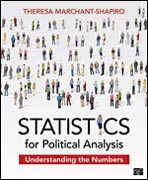
The author provides clear and accessible explanations and instruction, and takes a “how-to” approach, so students not only understand the maths, but can do the maths. Exercises include those requiring hand-calculations and those requiring a statistical package like SPSS, and ask students to produce memos to emphasize how marketable and applicable their new skills are to a broad array of careers and jobs. INDICE: 1. The Political Use of Numbers: Lies and Statistics The Power of Numbers The Science of Politics Introductory Statistics: An Overview Removing the Barriers to Understanding How Statistics Works The Importance of Statistics: This Book’s Approach Using Data to Answer a Question A Political Application: Indoctrination U. Your Turn: Using Statistics Apply It Yourself: Assess Grants to Political Scientists Key Terms2. Measurement: Counting the Biggel-Balls Finding Your Cases Measure an Attribute Evaluate the Conceptual and Operational Definitions Translate Information in Numbers: Coding Your Data Get a Frequency Distribution Summarizing the Process: Measurement Use SPSS to Answer a Question with Measurement Your Turn: Measurement Apply It Yourself: Measure the Norm for Chief Justice Appointments Key Terms3. Measures of Central Tendency: That’s Some Mean Baseball Measures of Central Tendency Summarizing the Math: Averages Use SPSS to Answer a Question with Averages Your Turn: Measures of Central Tendency Apply It Yourself: Calculate the Percent of Earned Income Key Terms4. Measures of Dispersion: Missing the Mark Ranges Distance from Mean Summarizing the Math: Dispersion Use SPSS to Answer a Question with Measures of Dispersion Your Turn: Measures of Dispersion Apply It Yourself: Evaluate Graduates’ Salaries Key Terms5. Continuous Probability: So What’s Normal Anyway? The Normal Curve Z-Scores Finding a Z-Score Use Probability to Calculate Z-Scores Summarizing the Math: Probabilities of Continuous Events Use SPSS to Answer a Question with Continuous Probability Your Turn: Continuous Probability Apply It Yourself: Evaluate the Murder Rate Key Terms6. Means Testing: Sampling a Population Type I and Type II Errors Means Testing Confidence Intervals: Two-Tailed Distributions Choose a Sample Size Summarizing the Math: Sampling a Population Use SPSS to Answer a Question with Means Testing Your Turn: Means Testing Apply It Yourself: Assess Maternal Mortality Rate Increases Key Terms7. Hypothesis Testing: Examining Relationships Hypothesis Testing Summarizing the Math: Hypothesis Testing and ANOVA Use SPSS to Answer a Question with ANOVA Your Turn: Hypothesis Testing Apply It Yourself: Examine Partisanship’s Affect on Feelings toward the Democratic Party Key Terms8. Describing the Pattern: What Do You See? Choosing the Appropriate Form of Presentation Graphs: Relationships and Scales Visualizing a Relationship: Contingency Tables Summarizing the Math: Graphs and Contingency Tables Use SPSS to Answer a Question Using a Contingency Table Your Turn: Describing the Pattern Apply It Yourself: Determine Stability across Legislative Systems Key Terms9. Chi-Square and Cramer’s V: What Do You Expect? The Probability of Discrete Events Chi-Square Cramer’s V Summarizing the Math: Chi-Square and Cramer’s V Use SPSS to Answer a Question with Chi-Square and Cramer’s V Your Turn: Chi-Square and Cramer’s V Apply It Yourself: Analyze Data by Type Key Terms10. Measures of Association: Making Connections Basic Principles of Measures of Association Pearson’s R Gamma Lambda Summarizing the Math: Measures of Association Use SPSS to Answer a Question with Measures of Association Your Turn: Measures of Association Apply It Yourself: Measure Poor Student Graduation RatesKey Terms11. Multivariate Relationships: Taking Control Spurious Relationships Interaction Effects Three-Way Contingency Tables Summarizing the Process: Setting Up Three-Way Contingency Tables Use SPSS to Answer a Question with a Three-Way Contingency Table Your Turn: Multivariate Relationships Apply It Yourself: Analyze Data on Race for Partisanship and Income Key Terms12. Bivariate Regression: Putting Your Ducks in a Line Graph a Relationship Fit the Data with the Ordinary Least Squares Estimate of the Line Find the Statistical Significance Find the Strength of the Relationship Use Regressions with Time Series Data Interpret Regressions with Dichotomous Independent Variables Summarizing the Math: Regression Use SPSS to Answer a Question with Bivariate Regression Your Turn: Bivariate Regression Apply It Yourself: Analyze Influences on Corruption Key Terms13. Multiple Regression: The Final Frontier Using Regression to Control for Other Variables The Assumptions of Regression Summarizing the Process: Multiple Regression Use SPSS to Answer a Question with Multiple Regression Your Turn: Multiple Regression Apply It Yourself: Evaluate the Impact of Multiple Factors on the 2012 Presidential Election Key Terms14. Understanding the Numbers: Knowing What Counts Measurement Univariate Statistics Multivariate Statistics Keeping the Numbers Meaningful Embracing the Uncertainty Key TermsReference MaterialsNotesGlossaryIndex
- ISBN: 978-1-4522-5865-2
- Editorial: CQ Press
- Encuadernacion: Rústica
- Páginas: 448
- Fecha Publicación: 31/03/2014
- Nº Volúmenes: 1
- Idioma:
